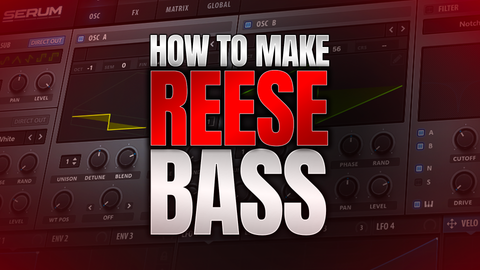✅Watch the Full Tutorial Here 🎥
You can follow along with this video tutorial for an in-depth look at Reese bass design!
👉 How to Make a Reese Bass for Drum and Bass – Serum Sound Design Tutorial
📺 Watch now:
Prefer to read? Keep scrolling for a written step-by-step breakdown of how to create the ultimate Reese bass for DnB! 🔥
Introduction
Reese basses are an essential element in Drum and Bass (DnB), bringing that iconic gritty, detuned low-end that makes tracks hit hard. Whether you're producing Jump-Up, Neurofunk, or Liquid DNB, mastering the Reese bass will take your sound to the next level ⭐️
In this guide, we’ll break down how to design a killer Reese bass from scratch using Serum and a few simple techniques. Plus, if you’re looking for ready-made sounds, check out our free DNB pack at this link!
What Is a Reese Bass?
A Reese bass is a detuned bass sound, commonly heard in Drum and Bass, Dubstep, and other bass-heavy genres. The principle behind it is simple:
✅ Two saw waves on the same octave
✅ Slight detuning between the waves
✅ Modulation & effects for movement
This creates a thick, wide, and evolving bass tone, making your DNB drops hit harder than ever.
Step 1: Setting Up Your Reese Bass in Serum
- Initialize Serum: Open Serum and load the default preset.
- Oscillator A & B: Set both to saw waves and drop them one octave down.
-
Detune the Oscillators: Slightly adjust the fine-tune setting:
- Oscillator A: Set to -30 cents
-
Oscillator B: Set to +30 cents
-
Control the Speed of Movement:
- A small detune (e.g., ±6 cents) creates slow phasing
- A larger detune (e.g., ±50 cents) makes it faster & aggressive
🎧 At this stage, you should already hear that classic “reesy” Reese effect!
Step 2: Adding Depth & Power
Sub Bass Layering
To ensure your Reese hits hard on big sound systems, add a sub-layer:
- Enable the Sub Oscillator in Serum
- Select a sine wave and drop it one octave lower
- Click "Direct Out" to keep it clean and separate from the FX chain
🎛 This keeps your low-end tight and powerful!
Adding White Noise for Grit
To bring extra texture and presence, add a Bright White Noise layer in Serum’s Noise Oscillator:
- Keep it at low volume (25%)
- This will be blended later with distortion
Step 3: Processing & FX for a Fat Sound
1. Filtering for Movement
- Add a low-pass filter
- Modulate the cutoff with an LFO to create movement
- Use a slow-moving LFO shape (4 bars recommended)
2. EQ Modulation for Dynamics
- Boost a resonant peak around 100-200Hz
- Add an LFO movement to the EQ for variation
3. Distortion for Warmth & Crunch
- Use Tube Distortion (Drive at 100%, Mix at 100%)
- Enable Post EQ to clean up unwanted harshness
4. Adding Phaser & Chorus for Stereo Width
- Phaser: Adds slight movement and width
- Chorus: Use a high-pass filter so only high frequencies are affected
5. Compression for Fatness
- Use Multiband Compression
- Boost the high-end slightly for extra crispiness
6. Reverb & Glide for Depth
- Add a short decay reverb (cut the low-end to keep the mix clean)
- Enable Mono Legato Mode in Serum with Portamento Time for smooth note transitions
Final Result: A Nasty Reese Bass for Your DNB Tracks!
By following these steps, you now have a massive Reese bass that’s perfect for Jump-Up, Neurofunk, and Liquid DNB. The best part? You can experiment with different:
🎛 Effects – Add more distortion or phaser for unique textures
🎵 LFO Movements – Speed up or slow down the modulation
🔊 Waveforms – Swap saw waves for squares or custom wavetables
Want instant inspiration? Grab our FREE DNB pack below for professionally designed Reese basses, drums, and FX ready to drop into your next track!
📥 Download Free DNB Pack here!
🎛 Looking for premium DNB packs? Check out our store for the hardest-hitting bass presets, samples, and more → noisemasters.eu
Final Thoughts
Mastering Reese basses is a must for any Drum and Bass producer. With the right techniques and sound design tricks, you can create huge, dynamic basslines that make your tracks stand out.
🔥 What kind of basses do you want to learn next? Let us know in the comments below!
And if you found this tutorial helpful, subscribe to our YouTube channel for more DNB sound design tips! 🚀



